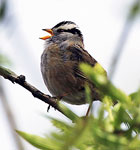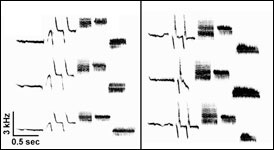 |
|||||||
| Biology Home | News | Calendar | Make a Gift | UW Alumni | |||||||
|
Spring 2009 | Return to issue home
How Songbirds Learn to Sing By Kristy Brady
Bird species are often identified by their songs, but songbirds do not hatch knowing how to sing a particular song. Juvenile songbirds learn to sing using a copycat approach; young males typically mimic their fathers. Experiments from the 1950s and 1960s showed that in the absence of a model to mimic, birds develop a very peculiar song. However, there is an innate sense to develop a particular sound and birds that are given a choice between models to mimic preferentially choose their own species over any other species. David Perkel, joint professor in biology and otolaryngology, researches the brain circuitry guiding the whole process of singing. That is, his lab examines how both song learning and production are wired in the brain. "Birds have collections of neurons called nuclei," Perkel explained, "which form information processing circuits. There are separate circuits for learning songs and for singing them." Though, as you might expect, the circuits interact. "We’re looking at song learning from the cellular level all the way to the behavioral level," Perkel said, "with the goal of linking all the levels together." On the cellular level Perkel’s lab continues to perform experiments to work out the basic circuitry, with interesting results. Recently they discovered a connection between the learning circuit and a site of dopamine production. "Dopamine is associated with reward so it could be important for mediating learning," Perkel said. One current hypothesis is that it may function as a reinforcing signal for good behavior, in this case a well-sung version of a song. The first step in testing this hypothesis is to measure when dopamine is released. If it is released at higher levels after a better song is sung, then they will test the hypothesis experimentally by trying to manipulate dopamine release; if not, they’ll develop a new hypothesis. Recording the activities of single cells is another method the Perkel lab uses to reveal electrophysiological patterns in the brain. Recordings of individual neurons reveal how synaptic contacts are made between cells and if and how these contacts differ between juvenile and adult brains. Single cell recordings also allow researchers to determine which neurotransmitters are released at a particular synapse.
On the behavioral level, recordings are made of birds’ responses to auditory stimulations. These recordings provide information on how a signal propagates through a neural circuit. Auditory stimuli include recordings of a bird’s own song, recordings of other birds’ songs within the same species, and bird songs of other species. These auditory response experiments have shown that neurons in the song circuits respond most strongly to a bird’s own personal song, providing reinforcement to the theory that song learning depends on auditory feedback. Seasonality of Songs There are over four thousand species of songbird and species vary in their song repertoire. Some species sing one song for life; others learn new songs all the time. But for many species, winter is a quiet season. When springtime arrives brain cells involved in producing songs need a refresher course. That is, adult songbirds have to tune-up their songs. In collaboration with Eliot Brenowitz, joint professor in biology and psychology, Perkel is looking at the electrophysiological changes in the brain during this tune-up stage. Fluxes of hormones such as androgens and estrogens in one region of the brain cause electrophysiological changes in brain regions downstream. Thus far this collaborative research has shown that these downstream changes are essential for some of the song modifications that occur in spring. Experiments revealed that if these hormonal changes are interrupted, birds fail to perfect their songs (see sonograms above). Understanding the neural circuitry of song learning in birds could well have implications for certain learning behaviors in humans. It turns out that even though the bird and mammal lineages split 300 million years ago, brain architecture is highly conserved between the two.Perkel’s lab has already identified one circuit in birds that is known to have a human parallel involved in human learning. Visit David Perkel's Web site to learn more about his research. Sparrow photo by Tsu-Wei Wang Spring 2009 | Return to issue home | |||||||
|
|||||||


